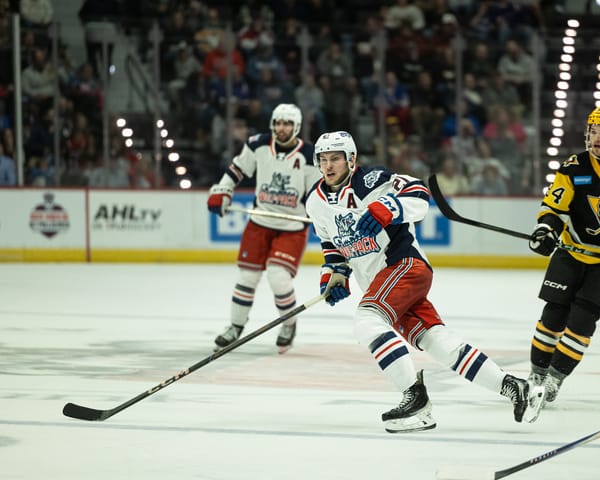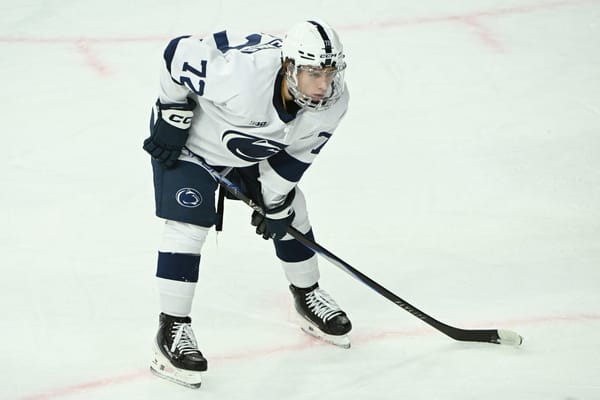The Rangers Now Have No Excuse For Not Playing the Kids on Defense
With expanded rosters and a delayed start to the AHL season, the Rangers might as well give their talented youngsters first bite at the apple.
Back in early October, NHL teams were still operating under the premise (or hope) that the 2020-21 season would operate under somewhat normal circumstances. The Rangers signed Jack Johnson and Anthony Bitetto on the first day of free agency with the explanation that the organization’s defensive depth was thin and the coaching staff needed veteran options available in case the team felt their prospects were not up to snuff.
The Rangers may not be in the throes of a rebuild for much longer, but this is still very much a long-term project. The debate for the team’s decision-makers would not be a direct evaluation of, for instance, Johnson versus K’Andre Miller. A more important consideration would be whether Miller’s long-term development would be better suited by playing a depth role at the high-pressure NHL level, or by getting a heavy workload in all situations in the AHL, where the environment is more forgiving and geared towards teaching.
If the team was to decide that Miller and others such as Tarmo Reunanen and Libor Hàjek were best served by starting the season in the AHL, then the Rangers would need alternative options available to step in on the NHL roster. The particular two defensemen the Rangers signed have track records of very poor performances in the NHL, but the general idea of adding two experienced players to the depth chart as insurance had merit.
Both the NHL and AHL have since come to terms with the limitations of a 2020-21 season and have created schedules and rules in line with the necessary pragmatism to make it possible. NHL training camp will begin on January 3rd, with teams having ten days and likely no preseason games to sort out their rosters before a 56-game season begins on the 13th and ends on May 8th.
Because of the extremely tight schedule, travel restrictions, and the potential for COVID infections, teams will be able to carry extra players as part of a “taxi squad.”
Taxi Squad details for the 2020-21 #NHL season:https://t.co/XpdrFRgPbt pic.twitter.com/5qNa7lA2ZL
— CapFriendly (@CapFriendly) December 20, 2020
The AHL season, meanwhile, is tentatively earmarked for a February 5th start. This completely changes the calculus in the Rangers’ decision-making regarding their prospects. There is a 23-day gap separating the beginning of the NHL season and the theoretical start of the AHL season, and the Rangers will likely be scheduled to play in the ballpark of 11 games in that timeframe. The debate following training camp will not be about whether prospects are better served in the NHL or AHL because there won’t be any AHL action. The choice will be between putting any of them in the lineup on gameday or letting them sit around doing nothing but practice and bag skates.
With that in mind, there is little reason not to give the prospects a chance. Specifically, K’Andre Miller. He turns 21 years old in January and last measured at 6’4”, 207 pounds. Questions about his NHL-readiness pertain to the technical and cognitive parts of the game, but this is not some awkward teenager who will be physically out of his depth and at risk on the ice against grown men.
The Rangers have every reason to get him into the lineup for at least some games during those first few weeks. At best, he holds his own and proves he belongs. And he very may well show that. His combination of size and skating ability can go a long way in erasing any errors or delays in judgment. If he plays well enough to earn an extended stay then it mitigates a tremendous migraine for a coaching staff that otherwise is entering the season with one competent left-handed defenseman.
Perhaps instead Miller struggles. For the sake of argument, let’s say that is the likelier outcome. What harm is done? The Rangers want to win games and the short season offers little room for error, but let’s be realistic about the team’s chances. The entire offseason was more or less a punt on 2020-21 in order to set itself up more favorably for the years beyond. The division the team is being thrown into is stacked and they face an uphill battle to make the playoffs, let alone make win a series or two.
More pointedly, if the Rangers do fall short, it won’t be because Jack Johnson, Brendan Smith, and Anthony Bitetto were in the press box for a handful of games in January. It’s hard to see how he could perform meaningfully worse than those three are likely to. At least Miller has something to learn from a bad shift or game.
The same thinking should apply to Tarmo Reunanen. He is a lesser prospect and my opinion is that he is not an NHL defenseman right now. But again, neither are the Rangers’ alternatives and decidedly so. At least with Reunanen it’s not a settled matter. In fact, as vehemently as I’ve argued that Hàjek is not an NHL-caliber defenseman, even he would be a better use of a lineup spot earlier in the season than the team’s veteran retreads. Maybe a long offseason plus another year of growth led to strides in his game and he proves my take completely wrong. If he again struggles immensely and proves unqualified, the sooner the organization comes to terms with that the better.
Can a young player’s development be hampered if a team overwhelms him at a level he isn’t ready for? Yes. I made the argument in March that this is what has happened with center Brett Howden. In his case, though, we’re talking about a player who spent the entirety of two seasons swimming against the current in the NHL. When it comes to Miller (or Reunanen, or Hàjek), we’re talking about a handful of games.
Ryan Lindgren aside, the Rangers are almost certain to get poor performances from their current group of left-handed veteran NHL defensemen. They have nothing to lose and everything to gain by instead using the early part of the regular season as a trial by fire for their prospects who inspire some measure of hope. Why not give them the opportunity? In even the worst-case scenario, it will give those players perspective on what it takes to make it in the NHL, and it will give the Rangers a deeper understanding of what inefficiencies the coaches in Hartford should focus on when they get sent to the AHL in February.




